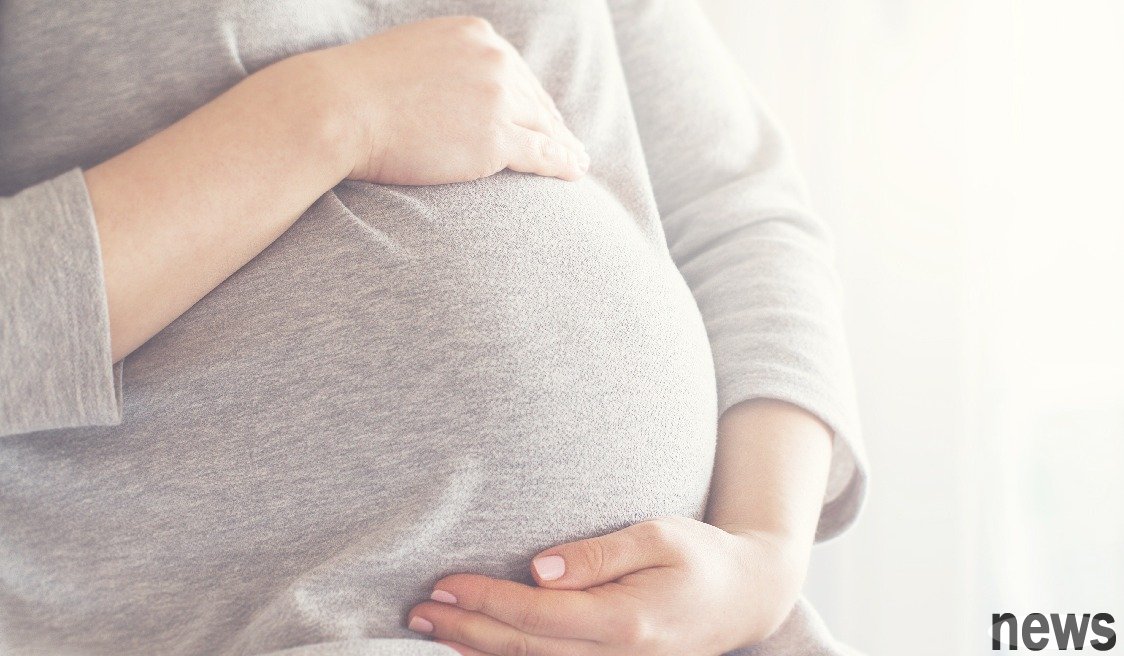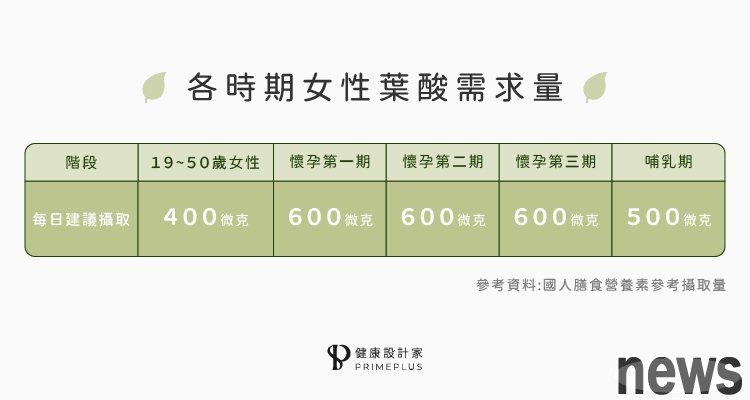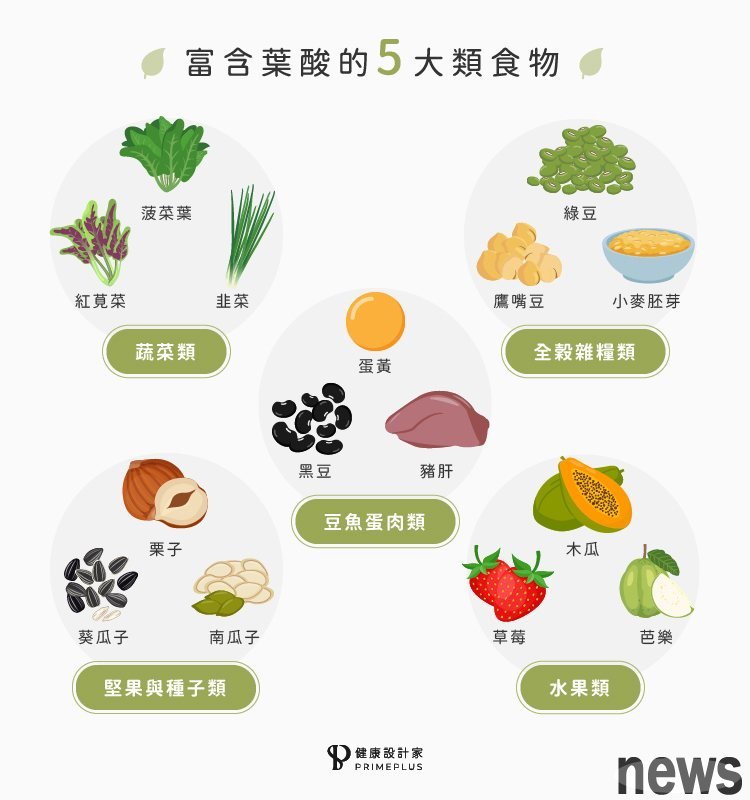
After the baby's croaking place, the joy of being a father and mother is expressed in words. Before welcoming a new life, pregnancy is a very special process in a woman's life. The growth and development of a baby depends entirely on the mother's body, and it is the most secret moment for the two. In order to make the fetus in the abdomen grow healthily, many mothers are very hardworking and want to help the baby get enough nutrition. I believe you must have heard that leaf acid is one of the most important nutrients for pregnant women, but do you know? According to the National Nutrition Survey from 106 to 109, one out of every ten women with aged women has a leaf acid deficiency! In order to make both mothers and babies strong and healthy, today [PrimePlus Health Designer] brand nutritionist Sean is coming to meet everyone with Leaf Sour!
Leaf Acid FunctionLeaf Acid, also known as vitamin B9, can be seen as one of the members of the vitamin B group and is also an essential nutrient for humans. It participates in important functions such as cell division, DNA synthesis, and red blood cell growth and maturation. If the body lacks leaf acid, new cells and blood cells will not be able to normally produce, which will lead to decreased immune function, blood dysfunction, and abdominal abdomen.
As for the reason why leaf acid is very important for babies and mothers, leaf acid can help the fetus develop and grow normally. The supplementation of leaf acid is very important in the early stages of pregnancy or even during pregnancy! Because the growth and closure of fetal neural tube will be completed from the third to the fourth week after conception, many women don’t even know that they are pregnant! If the leaf acid deficiency occurs in the early stage of pregnancy, it is likely to cause congenital neurotube defects such as fetal brain and spinal cord, self-experienced miscarriage, premature birth, and excessive birth. Pregnant mothers are prone to fatigue, depression, dizziness, and blood loss. Therefore, pay special attention to whether the leaf acid in your diet is sufficient.
How much leaf acid should I eat during pregnancy?Because pregnant women need to be cared for and have healthy growth, their nutritional needs are usually higher than those of ordinary people, and leaf acid is no exception. As for the daily leaf acid requirement, we can implement the daily diet plan based on the national dietary nutrition reference amount issued by the Ministry of Welfare. It is recommended for women who are a child to consume 400 micrograms of leaf acid every day; for women who are a pregnant woman should consume 600 micrograms of leaf acid every day from one month before conception to the entire pregnancy period; for women who are breastfeeding, it is recommended for women who are lactation to consume 500 micrograms of leaf acid every day to serve their own and their fetus needs.

Now we know the function of leaf acid and the amount we need to eat every day, but what exactly do we need to eat to supplement enough leaf acid? According to the analysis of ingredients, leaf acid is mainly found in five types of foods: vegetables, whole-limited roots, beans, eggs, fruits, seeds and fruits. Next, Sean will help you find ingredients rich in leaf acid from these five types of foods!
1. Vegetable leaf acid, the meaning of the name can be understood as it exists in the leaf. Among them, the leaf acid content of spinach leaves, red cabbage and leeks is richer. Each 100 grams of vegetables contains 232 micrograms, 210 micrograms, and 158 micrograms of leaf acid. If you are a vegetarian, you can make more use of it.
2. Full-grained penis with rich leaf acid content are mainly ginger beans, green beans, and wheat germ. Each 100 grams of them contains 742.1 micrograms, 414.6 micrograms, and 329.3 micrograms of leaf acid. It is worth noting that because the ginger beans and green beans are high in powder content, you should pay attention to the appropriate amount when consuming it!
3. Soybean, egg, meat, etc. The foods rich in leaf acid include black beans, pig liver, egg yellow and other foods. Each 100 grams of ingredients contain 721 micrograms, 677.6 micrograms, and 160.2 micrograms of leaf acid. I would like to remind everyone here that except for black beans, pig liver and egg yellow contain relatively high fat, and it is necessary to eat appropriate amounts and should not be too much, so as to avoid excessive weight increase after eating too much heat.
4. The leaf acid content of fruit and seed type fruit foods themselves is also very impressive. For example, sunflower seeds, pumpkin seeds, and chestnuts contain 272.5 micrograms, 213.0 micrograms, and 59.9 micrograms of leaf acid for every 100g. Considering that many fruit products on the market are flavoured, it is recommended to choose original fruits as much as possible to avoid too many corks or other additives. In addition, fruit foods contain higher oil and heat, so they should not be consumed too much.
5. Fruits with higher leaf acid content include: strawberries, bale, and papaya, which contain micrograms, 82.8 micrograms, 55.6 micrograms, and 47.3 micrograms per 100 grams. However, the fruit itself contains higher sugar content. While consuming fruits, you also need to pay attention to the amount to avoid difficult blood sugar control!

Parents all want their children to be strong, and sufficient nutrition is essential. But with the changes in the times, after entering the industrial and commercial society, life has gradually changed, and the chances of having a balanced nutrition meal have become less and less. Sean's friend is an example. He is obviously a pregnant woman, but she still has to work overtime every day, so she has no way to eat delicious food! For these groups that may have insufficient intake in daily diet, you can actually consider the natural source leaf acid supplements developed by trusted health food manufacturers, and use them under the guidance of professional medical practitioners to provide the most uninvested nutrition to mothers and babies. In addition, in order to improve the health of mothers, our government has increased the free birth test to 14 times starting from July 1, 2011, and has added gestational diabetes screening, blood test and 2 general ultrasonic tests. Moms can use it more! Sean wishes mothers happiness and joy and beauty to their family here!